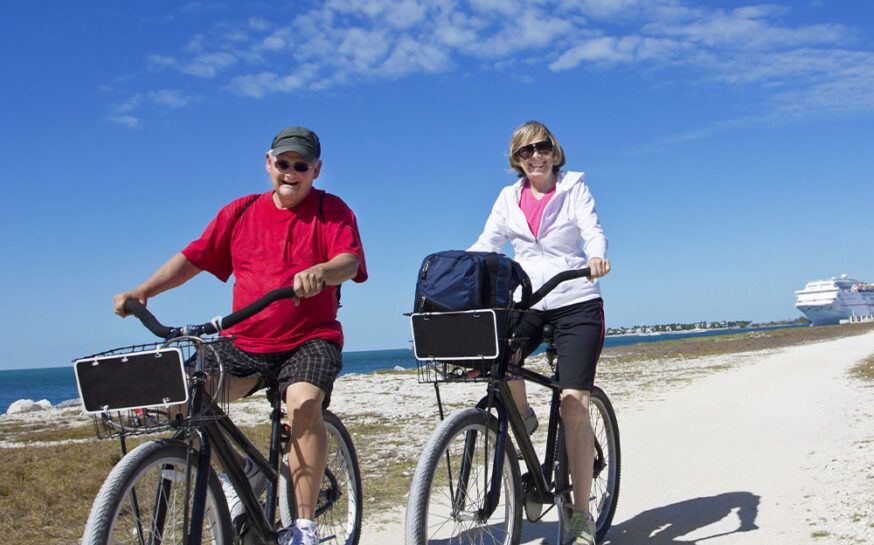Healthy aging is a complex concept influenced by various factors, movement being one of them. Staying active helps you move with ease, stay independent, and find comfort in doing what you love. But this is not just about strict exercise plans. Beyond that, it also involves getting regular movement through household chores, yard work, or lifestyle activities. Doing these helps you build strength, balance, and flexibility while also supporting your emotional well-being.
Why Staying Active Is Essential for Seniors
Even gentle activities like walking, stretching, or chair yoga can make a real difference in everyday life. Moving your body helps you enjoy the little moments – playing with grandchildren, tending to your garden, or taking a calm walk to your patio for evening tea. When you stay active, simple things like getting to the dining table at mealtime become easier and more comfortable. It’s not about doing more than you can. It’s about staying safe, feeling good, and keeping your body moving while staying comfortable. There are many ways to stay active that can make life feel brighter and more fulfilling.
Encourages Independence and Confidence
The road to independence often starts with movement. This means you need to be able to perform daily activities, pursue hobbies, and socialize with your community without relying heavily on others.
Importance
When you can cook, clean your house, or even reach and grab your favorite book effortlessly, you will feel capable and confident. This leads to a sense of accomplishment, which directly impacts your self-worth. Eventually, this can motivate you to pick up more demanding tasks, leading to a more fulfilling life.
How To Gain Independence Through Mobility
There are many useful strategies and practical tools that help you achieve independence and confidence in daily life. For example, you can start simple by making your bed or organizing your space. Use tools designed to streamline these tasks. Do these activities regularly to build muscle memory and to make them part of your routine. Start with small, realistic goals so that you don’t overwhelm yourself. Appreciate every milestone to improve your self-esteem. And most importantly, don’t hesitate to ask for help when needed. You need to consider obstacles as learning opportunities. Lastly, reflect on your daily progress and what you have learned to make practical adjustments to your routine.
Promotes Overall Well-being
When you stay active, all your body parts and systems benefit, leading to better overall well-being. Regular movement helps your cardiovascular system function smoothly, keeps your muscles strong, improves flexibility, and supports bone density. Together, these factors maintain your body’s rhythm.
Importance
Regular movement and exercise make daily life easier, whether it is basic tasks like carrying groceries or standing for long periods. Physical activity also builds up your body’s natural defenses, making it more resistant to a wide range of health problems.
How To Enhance Overall Well-Being Through Physical Activity
You can focus on gentle activities that reduce joint discomfort and stiffness caused by inactivity or some underlying conditions. Light stretching, walking, swimming, or chair exercises can keep your muscles engaged without strain. You have to move at your own pace and as per your body’s comfort levels. Low-intensity aerobic exercises improve the delivery of oxygen and nutrients throughout the body.
Improves Balance and Reduces Fall Risk
Good balance gives you freedom, letting you move confidently from one place to another without risking a fall. As you grow older, staying steady becomes more than just avoiding falls; it’s about trusting your movements without fear or hesitation.
Importance
Falls become a serious concern with age. The fear is no longer just of scraping a knee or dealing with a wound. With age, your body’s healing and coping mechanisms slow down, which makes falls and accidents a major concern. Your body might no longer be able to take the same impact as it once did.
How To Improve Balance and Reduce Falls by Staying Active
Balance exercises can strengthen your muscles, improve coordination, and reduce reaction times, helping prevent accidents. Try activities that help you strengthen your back and core muscles. Doing this helps you walk with an upright posture, further improving your stability.
Heel-to-toe walks, gentle side steps, or light stretches can strengthen the muscles in your ankles, hips, and core, keeping them responsive. These improvements reduce the risk of falling during everyday tasks.
Boosts Emotional Well-being
Besides your physical well-being, exercise and regular movement are also great ways to stay emotionally positive. Engaging in fitness activities triggers the release of endorphins, which relieves stress and promotes relaxation.
Importance
Regular exercise improves blood flow to the brain. This, in turn, leads to better memory and focus. Staying active also helps regulate your breathing and calms your nervous system. Eventually, it will lead to better sleep quality and emotional clarity, helping you worry less and manage stress more effectively.
How To Boost Emotional Well-Being Through Exercise
Brisk walking, dancing, cycling, and gardening boost mood and improve sleep. On the other hand, moderate-intensity strength training exercises can promote relaxation and improve your self-esteem. Exercising with friends or within a small group can make things even more enjoyable; you move, laugh, and share moments that strengthen connection and joy.
Types of Fitness and Mobility Activities for Seniors
Gentle Stretching and Flexibility Exercises
Stretching doesn’t have to be limited to the start of an exercise routine. It can simply be part of the movement you include throughout the day, beyond your usual activity. Regular stretching helps keep joints flexible, muscles relaxed, and the body more agile, while also supporting better circulation and posture.
Types of Stretching Activities
- Morning Routine: Start the day with a few rounds of light stretches. Your muscles can tighten overnight, which is why you have a limited range of motion in the morning. Breathe deeply, tilt your neck, roll your shoulders, extend your arms overhead, and rotate your ankles. These light stretches help you start your day right.
- Chair-Based Stretches: On busier days, chair-based stretches are a convenient alternative. You can do these workouts anywhere, anytime. Whether you are watching television, listening to music, or just finished your walk routine, chair stretches make movement an easy part of everyday life. Seated side bends, overhead stretches, and neck-rolls will gently help you release tension in your neck, shoulders, and back.
- Assisted Stretching with Bands: Resistance bands are an excellent addition to your fitness routine. They can help you add gentle tension to regular movements and activate your muscles without straining your joints. The elasticity of the resistance band also supports a wider range of motion and stronger muscles. You can use these bands for seated arm extensions, side pulls, leg presses, and more. Since these bands come in varying resistance levels, choose the one that feels most comfortable.
Strength and Resistance Training
Your muscles naturally lose strength and mass with age. This is a natural process and is known as sarcopenia. Albeit normal, you can slow this process by regularly practicing strength and resistance training. When you focus on building strength, tasks such as standing up from a couch or chair, climbing stairs, and carrying groceries become safer and easier.
Types of Strength and Resistance Training Activities and Their Benefits
- Aerobic exercises like brisk walking, cycling, or swimming, and muscle-strengthening activities such as weight lifting or bodyweight workouts, are optimal for improving metabolism, joint stability, and longevity. For best results, you combine these workouts across different days of the week.
- Seated leg lifts with ankle weights strengthen leg muscles, improve stability, and make it easy for you to walk and stand.
- Mini squats, grip-strength exercises, and resistance-band rows are safe and easy to practice.
For safe training, focus on your form rather than the number of repetitions. This will ensure your muscles are properly engaged and prevent injuries. Rely on stable surfaces to avoid any unwanted accidents. It is equally important that you maintain rhythmic breathing and keep track of your progress.
Balance and Coordination Exercises
When you practice balance exercises, you establish enhanced communication between your brain and body. Plus, these exercises also strengthen your core and lower body muscles, which helps support joints and improve posture.
Types of Balance and Coordination Exercises
- Tandem walking improves coordination and strengthens your ankles, making you steadier and more sure-footed.
- Supported single-leg stands, tai chi, and chair-based exercise drills can make simple everyday movements, such as walking and climbing stairs, easier and safer.
Remember, balance training isn’t just about preventing falls. It will also help restore your confidence. You would be more active and mobile when you feel steady, and to achieve that feeling, consistent movement is essential.
Low-Impact Aerobic Activities
You can practice aerobic exercises both indoors and outdoors. They benefit several bodily systems and allow you to stay physically active without stressing your joints.
Types of Low-Impact Aerobic Activities
- Walking, gardening, and swimming help boost your heart, mind, and energy levels.
- If you prefer to spend most of your time indoors, you can practice stationary cycling, seated marching, water aerobics, and a variety of dance-based workouts.
Even 10-minute sessions, done 2 to 3 times a week, can benefit you. It will improve your cognitive function, stamina, energy levels, and circulation.
Mind-Body Fitness Workouts
As your body gets stronger and healthier through exercise, it’s equally important to look after your brain to keep it sharp and active. This means working on achieving better focus and emotional balance. Mind-body exercises include movements that encourage bodily awareness, deep breathing, and controlled movements.
Types of Mind-Body Fitness Workouts
- Tai Chi involves slow, gentle, flowing movements, deep breathing, and mental focus to improve balance and reduce stress.
- Chair yoga combines poses, breathing exercises, and meditation to improve flexibility, strength, and balance.
These activities will help you manage chronic tension and pain, build emotional resilience, and improve fluidity in movement.
Ways To Make Staying Active Engaging
Group Movement Sessions
Exercising in a group setting offers opportunities for you to meet new people and build connections. This turns movement into a fun activity. Being part of a group builds motivation, as the shared commitment and expectation from others make it harder to skip a session. Joining groups or clubs for activities such as stretching, yoga, walking, dance, water aerobics, spin lessons, or balloon volleyball can help relieve isolation and provide gentle exercise. You can also join your friends for fitness- or recreation-focused activities, such as low-impact sports or cooking lessons, to keep your body and mind active and engaged.
Mobility-Focused Rehabilitation Activities
If you are dealing with stiffness or chronic pain, guided exercise programs can help you gradually restore your range of motion, renew confidence, and rebuild your strength. An experienced therapist can help you follow a structured plan that focuses on your rehabilitation, gait training, fine motor skills, joint mobilization, and stretch-and-strengthen routines. These practices focus on rebuilding movement one step at a time, helping your body regain its natural ease.
Create a Safe and Comfortable Routine
Before starting any fitness routine, you should speak to a qualified expert. Starting your gym journey without proper planning and preparation might do more harm than good. Look for a coach or fitness expert who understands your unique needs and can tailor training to your abilities.
- Start slowly and gradually build up your routine. Doing it right is more important than finding out the weight or the number of repetitions you hit at the end of the session.
- Carry a bottle of water with you and keep sipping during your exercise breaks to stay properly hydrated.
- Set realistic goals after discussing with your trainer, and adjust your workouts accordingly.
- Exercise in a bright, clutter-free space with high-quality, non-slip mats, sturdy chairs, and handrails to ensure safety.
- Always listen to your body. Some days will feel easier than others, but consistency makes all the difference. Stop when you feel exhausted. Do not create excuses to escape workouts.
- Choose comfortable, breathable clothing and supportive footwear.
- Maintain a steady pace; avoid sudden or jerky movements.
- Rest between sets and allow recovery days.
- Do your planned workouts regularly. Exercising even a few minutes daily is better than pushing yourself too hard once a week.
The Role of Professional Guidance
Professional trainers and fitness experts can help you follow a safe training program. They help you identify the safest way to start and follow the best exercises for your joint health, stamina, or recovery needs. These experts will also help you track your progress, adjust your workouts for your changing needs, and push you to work out consistently. This helps you stay motivated, consistent, and confident. Plus, they will provide consistent inputs and updates to help you stay on track and exercise safely. With their supportive guidance, movement becomes smoother and more rewarding.
Overcoming Common Barriers to Staying Active
If you hesitate to start exercising due to fear, pain, or lack of motivation, it is common. The key is to start easy, for example, chair-based or supported exercises. You can also try low-impact workouts, such as water aerobics or stretching. Use adaptive equipment and seek professional help when needed. Starting small and focusing on realistic goals helps you build confidence and make movement part of your routine.










There are no comments yet